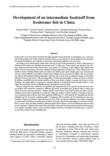Development of an intermediate foodstuff from freshwater fish in China
JIRCAS international symposium series
| ISSN | 13406108 |
|---|---|
| 書誌レコードID(総合目録DB) | AA1100908X |

本文フルテキスト
intlsymp-11_122-129.pdf388.06 KB
Frozen surimi is an intermediate foodstuff with high potential for long shelf life, for distribution over a wide area, and for the production of various texturized products. Hence, a vast quantity of cultured freshwater fish should be developed and utilized as new materials in surimi and surimi-based products in the near future.
According to three-dimensional contour maps showing the gel-forming properties of surimi, eight species of freshwater fish surimi were classified into two types: the 'V-valley-type' surimi (silver carp, big-head carp, Chinese snake-head and blunt-snout bream) shows easy setting, low resistance to gel collapse, high enhancement ability with two-step heating, and narrow optimum heating temperature and time area. These characteristics are similar to those of walleye pollack surimi. In contrast, the 'plateau-type' surimi (tilapia, grass carp, mud carp and common carp) is difficult to set, highly resistant to gel collapse, has no enhancement ability with two-step heating, and has wide optimum heating temperature and time area. As well, there are seasonal changes in the gelling properties of silver carp surimi, with the setting ability of surimi gel being higher in winter and lower in summer. In addition, myofibrillar protein thermal stability of silver carp surimi is higher in summer and lower in winter. Therefore, the setting ability of surimi gel is evidently affected by myofibrillar protein thermal stability, i.e. the bigger the inactivation rate of myofibrillar protein, the higher the rate of setting.
Sensory evaluations were conducted on kamaboko gels prepared from silver carp (SC) surimi and from walleye pollack (WP) surimi for comparison. Different specimens of kamaboko gel, produced with or without the extract from silver carp muscle (Esc) or walleye pollack muscle (Ewp), were tested for their odor, flavor, texture, whiteness and overall acceptability by a panel of college-age students in three locations. According to the sensory evaluation results in Kyoto, there were significant differences (P < 0.05) between SC kamaboko gel and WP kamaboko gel for all sensory evaluation indices. Compared to WP kamaboko gel, SC kamaboko gel was unacceptable to Japanese consumers, especially due to its odor. When the same investigations were made in Shanghai (a coastal area) and Wuhan (an inland area) of China, the former showed the same pattern as observed in Kyoto, but to a lesser extent; the latter exhibited a different pattern than in Kyoto, with fewer differences between all of the test specimens. Students from inland China found the marine fish meat gels and the freshwater fish meat gels to be equally acceptable. Sensory scores increased slightly when Ewp was added to kamaboko gels-in particular, the odor scoring of the SC kamaboko gel.
According to three-dimensional contour maps showing the gel-forming properties of surimi, eight species of freshwater fish surimi were classified into two types: the 'V-valley-type' surimi (silver carp, big-head carp, Chinese snake-head and blunt-snout bream) shows easy setting, low resistance to gel collapse, high enhancement ability with two-step heating, and narrow optimum heating temperature and time area. These characteristics are similar to those of walleye pollack surimi. In contrast, the 'plateau-type' surimi (tilapia, grass carp, mud carp and common carp) is difficult to set, highly resistant to gel collapse, has no enhancement ability with two-step heating, and has wide optimum heating temperature and time area. As well, there are seasonal changes in the gelling properties of silver carp surimi, with the setting ability of surimi gel being higher in winter and lower in summer. In addition, myofibrillar protein thermal stability of silver carp surimi is higher in summer and lower in winter. Therefore, the setting ability of surimi gel is evidently affected by myofibrillar protein thermal stability, i.e. the bigger the inactivation rate of myofibrillar protein, the higher the rate of setting.
Sensory evaluations were conducted on kamaboko gels prepared from silver carp (SC) surimi and from walleye pollack (WP) surimi for comparison. Different specimens of kamaboko gel, produced with or without the extract from silver carp muscle (Esc) or walleye pollack muscle (Ewp), were tested for their odor, flavor, texture, whiteness and overall acceptability by a panel of college-age students in three locations. According to the sensory evaluation results in Kyoto, there were significant differences (P < 0.05) between SC kamaboko gel and WP kamaboko gel for all sensory evaluation indices. Compared to WP kamaboko gel, SC kamaboko gel was unacceptable to Japanese consumers, especially due to its odor. When the same investigations were made in Shanghai (a coastal area) and Wuhan (an inland area) of China, the former showed the same pattern as observed in Kyoto, but to a lesser extent; the latter exhibited a different pattern than in Kyoto, with fewer differences between all of the test specimens. Students from inland China found the marine fish meat gels and the freshwater fish meat gels to be equally acceptable. Sensory scores increased slightly when Ewp was added to kamaboko gels-in particular, the odor scoring of the SC kamaboko gel.
| 作成者 | Xichang Wang Yutaka F ukuda Shunsheng Chen Masahito Yokoyama Yudong Cheng Chunhong Yuan Yinghong Qu Morihiko Sakaguchi |
|---|---|
| 公開者 | Japan International Research Center for Agricultural Sciences |
| オンライン掲載日 | |
| 号 | 11 |
| 開始ページ | 122 |
| 終了ページ | 129 |
| 言語 | eng |
